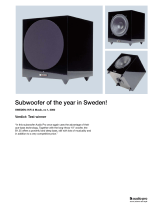
adjusts the phase automatically, but if GLM
is not available, the following manual phase
matching can be applied.
Manual Phase
Adjustment Method
Genelec 7360A and 7370A subwoofers are
equipped with a built-in 85 Hz frequency
test tone generator for phase alignment.
The test tone generator is connected to
the subwoofer's "TEST 1" output. Connect
temporarily a monitor to this output for
manual phase alignment.
Power up the system and set the TEST
TONE switch to "ON." Now you can hear an
85 Hz test signal from the subwoofer and
the main monitor connected to the center
channel output.
1. Toggle the -180° phase switch on and o,
and set it to the position which gives the
lowest sound level at the listening position.
2. Next toggle the -90° phase switch on and
o, and again set it to the position which
gives the lowest sound level.
3. Finally, set the -180° phase switch to
the opposite setting and deactivate the
test signal. The phase adjustment is now
complete.
Using the LFE +10 dB
Function
Dolby Digital and DTS encoding formats
present the LFE channel with +10 dB gain
relative to the main channels. Surround
sound decoders may automatically add
+10 dB of LFE gain to restore the level
balance.
The “LFE +10 dB” function can add the
+10 dB of gain to the LFE channel in the
production stage if it is not already done
by the source connected to the monitoring
system. Switching the “LFE +10 dB” switch
to the “ON” position activates the function.
If the LFE output is at a 10 dB higher level
than other (non-LFE) channels, this switch
should be set to “OFF”.
The “LFE +10 dB” function should not be
used in the following cases:
• If the +10 dB LFE gain is already
implemented by another device, for
example, a surround sound processor or
the output matrix of a mixing console.
• When producing an audio format that
does not require the use of +10 dB gain
on the LFE channel.
Additional Information
Positioning Subwoofer in Room
The location of the subwoofer can affect
the frequency response and sound level
dramatically particularly when the room
acoustic effects are strong. Even small
changes in a subwoofer's location can make a
marked dierence in the frequency response.
To begin, place the subwoofer at the front
wall slightly offset from the room center
line. Often methodical experimentation is
needed to nd the location giving the attest
frequency response at the listening location.
Usually the subwoofer is placed close to
a wall as this usually creates the highest
output. Positioning the subwoofer close to a
corner boosts the bass level and may cause
asymmetrical spatial imaging. Measured from
the subwoofer's driver the recommended
distance to a wall is less than 0.6 m (24 in).
Cancellations from the wall are then avoided.
Operating Environment
These subwoofers are designed for
indoor use only. The permissible ambient
temperature is 15-35 degrees Celsius
(50-95°F) and relative humidity 20% to
80% (non-condensing). When the product
has been stored or transported in cool
environment and is taken into a warm room,
wait 0.5-1 hours before opening packing to
prevent condensation of humidity before
connecting to mains power.
Minimum Clearances
Do not cover the grille or place the subwoofer
so that there is less than 0.1 m (4 in) of free
space in front of the grille. The space must
be ventilated or suciently large to dissipate
heat so that the ambient temperature
does not rise above 35 degrees Celsius
(95°F). Make sure that the space under the
subwoofer allows air flow. Thick carpets
may block ventilation needed for cooling the
electronics. The reex port opening should
have a clearance of at least 7.5 cm (3 in) to
ensure functioning of the reex port.
Flush Mounting
When the subwoofer is ush mounted in a
wall or cabinet, ensure unrestricted airow
in the reflex port and amplifier cooling.
Make the recess 7.5 cm (3 in) wider than the
subwoofer. Place the subwoofer to the right
side of the recess if the driver is facing the
room. This leaves sucient free space at
the reex port side. The height and depth of
the recess should not be much bigger than
needed for ventilation as this may cause
unwanted acoustic eects.
Using Multiple Subwoofers
Multiple Genelec 7360A or 7370A
subwoofers can be coupled together in high
SPL applications. The necessary cabling is
dierent for digital and analogue signals.
Digital Cabling
Run a signal cable from the AES/EBU OUT
connector of the rst subwoofer in the chain
to the AES/EBU IN connector of the next
subwoofer. Check that the Digital LFE and
LFE Channel A/B control switches have the
same settings in all subwoofers in the chain.
Analogue Cabling
When daisy-chaining multiple subwoofers
with analogue signals, run a cable from the
Link Out connector to the next subwoofer’s
Link In connector. When using the LFE
signal, also run a cable from the LFE Out to
the next subwoofer’s LFE In.
Control Switch Settings
When Using Multiple Subwoofers
When using GLM and its AutoCal function
for calibration, no manual adjustments on the
control switches are necessary. If GLM is not
available, manual adjustments are needed.
1. Calibrate the subwoofers one by one with
all other subwoofers in the chain switched
o. Start with the rst subwoofer.
Figure 4. Flush mounting the
subwoofer. Note the clearance needed
on the reex port side.








